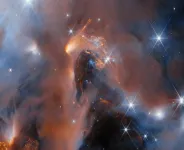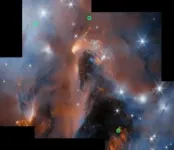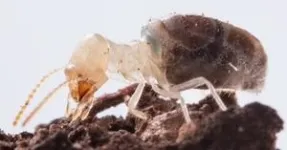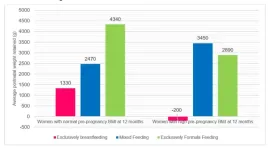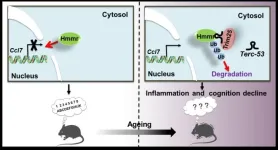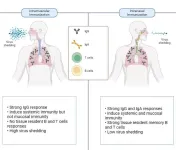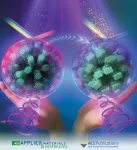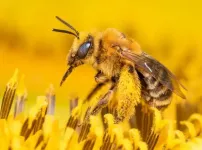(Press-News.org) The James Webb Space Telescope has spotted six likely rogue worlds—objects with planetlike masses but untethered from any star’s gravity—including the lightest ever identified with a dusty disk around it.
The elusive objects offer new evidence that the same cosmic processes that give birth to stars may also play a common role in making objects only slightly bigger than Jupiter.
“We are probing the very limits of the star forming process,” said lead author Adam Langeveld, an astrophysicist at Johns Hopkins University. “If you have an object that looks like a young Jupiter, is it possible that it could have become a star under the right conditions? This is important context for understanding both star and planet formation.”
The findings come from Webb’s deepest survey of the young nebula NGC1333, a star-forming cluster about a thousand light-years away in the Perseus constellation. A new image from the survey released today by the European Space Agency shows NGC1333 glowing with dramatic displays of interstellar dust and clouds. A paper detailing the survey’s findings has been accepted for publication in The Astronomical Journal.
Webb’s data suggest the discovered worlds are gas giants 5-10 times more massive than Jupiter. That means they are among the lowest-mass objects ever found to have grown from a process that would generally produce stars and brown dwarfs, objects straddling the boundary between stars and planets that never ignite hydrogen fusion and fade over time.
“We used Webb’s unprecedented sensitivity at infrared wavelengths to search for the faintest members of a young star cluster, seeking to address a fundamental question in astronomy: How light an object can form like a star?” said Johns Hopkins Provost Ray Jayawardhana, an astrophysicist and senior author of the study. “It turns out the smallest free-floating objects that form like stars overlap in mass with giant exoplanets circling nearby stars.”
The telescope’s observations revealed no objects lower than five Jupiter masses despite possessing sufficient sensitivity to detect such bodies. That’s a strong indication that any stellar objects lighter than this threshold are more likely to form the way planets do, the authors concluded.
“Our observations confirm that nature produces planetary mass objects in at least two different ways—from the contraction of a cloud of gas and dust, the way stars form, and in disks of gas and dust around young stars, as Jupiter in our own solar system did,” Jayawardhana said.
The most intriguing of the starless objects is also the lightest, having an estimated mass of five Jupiters (about 1,600 Earths). The presence of a dusty disk means the object almost certainly formed like a star, as space dust generally spins around a central object in the early stages of star formation, said Langeveld, a postdoctoral researcher in Jayawardhana’s group.
Disks are also a prerequisite for the formation of planets, suggesting the observations may also have important implications for potential “mini” planets.
“Those tiny objects with masses comparable to giant planets may themselves be able to form their own planets,” said co-author Aleks Scholz, an astrophysicist at the University of St Andrews. “This might be a nursery of a miniature planetary system, on a scale much smaller than our solar system.”
Using the NIRISS instrument on Webb, the astronomers measured the infrared light profile (or spectrum) of every object in the observed portion of the star cluster and reanalyzed 19 known brown dwarfs. They also discovered a new brown dwarf with a planetary-mass companion, a rare finding that challenges theories of how binary systems form.
“It’s likely that such a pair formed the way binary star systems do, from a cloud fragmenting as it contracted,” Jayawardhana said. “The diversity of systems that nature has produced is remarkable and pushes us to refine our models of star and planet formation.”
Rogue worlds may originate from collapsing molecular clouds that lack the mass for the nuclear fusion that powers stars. They can also form when gas and dust in disks around stars coalesce into planetlike orbs that are eventually ejected from their star systems, probably because of gravitational interactions with other bodies.
These free-floating objects blur classifications of celestial bodies because their masses overlap with gas giants and brown dwarfs. Even though such objects are considered rare in the Milky Way galaxy, the new Webb data show they account for about 10% of celestial bodies in the targeted star cluster.
In the coming months, the team will study more of the faint objects’ atmospheres and compare them to heavier brown dwarfs and gas giant planets. They have also been awarded time on the Webb telescope to study similar objects with dusty disks to explore the possibility of forming mini planetary systems resembling Jupiter’s and Saturn’s numerous moons.
Other authors are Koraljka Mužić and Daniel Capela of Universidade de Lisboa; Loïc Albert, René Doyon, and David Lafrèniere of Université de Montréal; Laura Flagg of Johns Hopkins; Matthew de Furio of University of Texas at Austin; Doug Johnstone of Herzberg Astronomy and Astrophysics Research Centre; and Michael Meyer of University of Michigan, Ann Arbor.
The Deep Spectroscopic Survey for Young Brown Dwarfs and Free-Floating Planets used the Near Infrared Imager and Slitless Spectrograph (NIRISS) instrument on the James Webb Space Telescope, a collaboration between NASA, the European Space Agency, and the Canadian Space Agency.
The authors acknowledge support from the UKRI Science and Technology Facilities Council, the Fundação para a Ciência e a Tecnologia (FCT), the U.S. National Science Foundation, and the National Research Council of Canada.
END
In six new rogue worlds, Webb Telescope finds more star birth clues
2024-08-27
ELSE PRESS RELEASES FROM THIS DATE:
Star lives and afterlives
2024-08-27
A two-faced star, a star as massive as the Sun but as compact as the Moon, and star ‘corpses’ that engulf entire planets and disrupt planetary orbits. Ilaria Caiazzo, an astrophysicist who has made stunning discoveries, joins the Institute of Science and Technology Austria (ISTA) as a new assistant professor. Her path led her from philosophy to studying stellar evolution and death while managing her broad interests including movie production.
Ilaria Caiazzo has always had a broad spectrum of interests. Her path to astrophysics started in philosophy and ...
Dungeons and Dragons can help autistic people gain confidence and find their inner hero
2024-08-27
Dungeons and Dragons is a hugely popular roleplaying game enjoyed by millions of people all over the world, both in person and online, every day.
However, new research has found it could be particularly beneficial for people with autism, giving them a safe space to engage in social interactions away from some of the challenges they face in their daily lives.
The study, published in the journal Autism, was led by researchers from the University of Plymouth’s School of Psychology along with colleagues at Edge ...
KKH study: Exclusive breastfeeding leads to greater weight loss in women with high body mass index as compared to women with normal weight
2024-08-27
27 August 2024, Singapore – A KK Women’s and Children’s Hospital (KKH) study[1] on breastfeeding practices revealed that among the women who exclusively breastfed, those with high body mass index[2] (BMI) before pregnancy lost more weight than women with a healthy BMI pre-pregnancy.
Women with high BMI who exclusively breastfed, in addition to losing their pregnancy weight, lost an extra 200 grammes on average, 12 months after childbirth. Women with normal BMI who exclusively breastfed lost weight ...
Noncoding RNA Terc-53 and hyaluronan receptor Hmmr regulate aging in mice
2024-08-27
The authors investigate the physiological functions of Terc-53 by creating transgenic mice that overexpress this noncoding RNA. They observe that Terc-53 overexpression affects normal aging in mammals, contributing to cognitive decline and shortened lifespan. Mechanistically, they find that Terc-53 binds to and promotes the degradation of Hmmr, leading to enhanced inflammation in tissues and accelerated aging. They also note that Hmmr levels decrease with age in certain brain regions, similar to Terc-53's pattern, and that restoring Hmmr levels can improve cognitive abilities ...
Game-changing needle-free COVID-19 intranasal vaccine
2024-08-27
A next-generation COVID-19 mucosal vaccine is set to be a gamechanger not only when delivering the vaccine itself, but also for people who are needle-phobic.
New Griffith University research, published in Nature Communications, has been testing the efficacy of delivering a COVID-19 vaccine via the nasal passages.
Professor Suresh Mahalingam from Griffith’s Institute for Biomedicine and Glycomics has been working on this research for the past four years.
“This is a live attenuated intranasal vaccine, called CDO-7N-1, designed ...
Preventing counterfeiting by adding dye to liquid crystals to create uncrackable coded tags
2024-08-27
A research group led by Nagoya University has developed an innovative approach to creating anti-counterfeiting labels for high-value goods. Their findings, published in ACS Applied Materials & Interfaces, enhance the security of the currently used cholesteric liquid crystals (CLCs) by adding fluorescent dyes to produce florescent CLCs (FCLCs).
Using this unique technology, the group created unique labels with almost impossible-to-counterfeit security features. These advanced labels are designed to protect valuable items, important documents, and sensitive products ...
Beckman announces 2024 research seed grant awardees
2024-08-27
The Beckman Institute for Advanced Science and Technology funded two research projects in 2024 as part of its research seed grant program. The program supports interdisciplinary research projects and is now in its second year.
This year, two research projects beginning in May 2024 received $75,000 per year for up to two years.
Research projects seeded by the Beckman Institute anticipate growth and typically lead to external funding proposals after the two-year seeding term.
Exploring how ASD-related genes influence brain networks that guide behavior
The CDC estimates that “1 in 36 children has been identified with autism spectrum disorder,” or ASD.
ASDs ...
Are crops worldwide sufficiently pollinated?
2024-08-27
A team of researchers led by Rutgers University-New Brunswick scientists has analyzed crop yields of more than 1,500 fields on six continents, and found that production worldwide of important, nutritionally dense foods such as fruits, vegetables, nuts and legumes is being limited by a lack of pollinators.
The results, detailed in Nature Ecology & Evolution, showed that across diverse crops and locations, one-third to two-thirds of farms contain fields that aren’t producing at the levels they should be due to a lack of pollinators. The phenomenon of a low crop yield because of insufficient visits by insects is known as pollinator limitation.
The ...
American Meteorological Society announces 2025 weather, water, and climate honorees
2024-08-27
The American Meteorological Society is proud to announce its 2025 Awards and Honors, recognizing outstanding contributions to the weather, water, and climate community. 2025 recipients will be honored at the 105th AMS Annual Meeting in New Orleans, 12–16 January, 2025.
“One of our key priorities at AMS is to recognize the work of our global weather, water, and climate enterprise for the impact they have on scientific advancement and public safety, as well as on economic growth for all communities,” says Awards Oversight Committee Chair ...
Montana State scientists publish bacterial immune research in Nature
2024-08-27
BOZEMAN – Scientists at Montana State University have been studying unique immune systems for decades, and a research team in the Department of Microbiology and Cell Biology took another step forward with work described in a paper published in the highly regarded journal Nature.
The Aug. 7 paper, titled “A virally-encoded tRNA neutralizes the PARIS antiviral defense system,” was fast-tracked for publication by the journal due to the importance of the findings. MSU doctoral student ...
